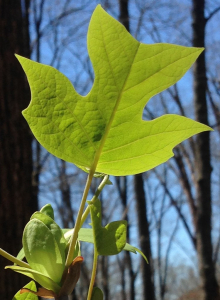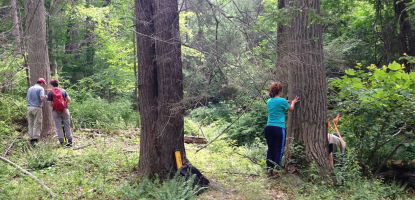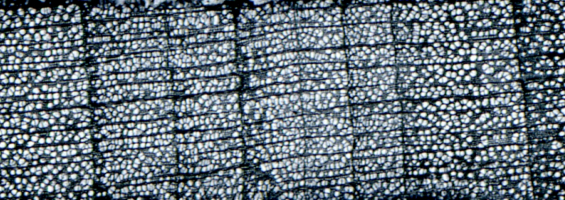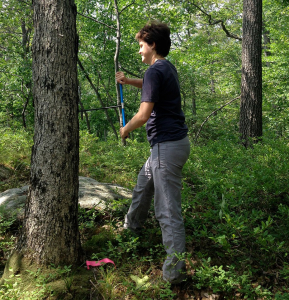You are here
Study: Decades of Tree Rings Extend Today's High-Tech Climate Stories

Satellite imagery, carbon dioxide measurements, and computer models all help scientists understand how climate and carbon dynamics are changing in the world’s forests. But the technology powering these high-tech data only stretches back about thirty years, limiting our picture of long-term change.
A new study in Nature Communications co-authored by HF Senior Ecologist Neil Pederson with scientists from Columbia University, ETH Zürich, and elsewhere shows how information revealed by a new method of analyzing tree rings matches the story told by more high-tech equipment over the short-term. Because trees are long-lived, looking back in their rings with this new approach may add decades or even centuries to our understanding of carbon storage and climate change in forests.
To test whether tree rings are a good proxy for satellite and other data, the scientists examined ring samples from two widespread tree species -- tulip poplar (Liriodendron tulipifera) and northern red oak (Quercus rubra) – growing in three climatically different regions of the eastern US.
By analyzing the carbon and oxygen molecules (stable isotopes) stored in the rings, they could compare the trees' own picture of forest productivity to estimates derived from satellites. They found strong agreement each year, and over time.
The tree rings also revealed that the biggest changes in annual forest growth were linked to moisture availability, regardless of climate. "Our method showed that the productivity of a forest can be estimated using information from just five trees," says Laia Andreu Hayles, an Associate Research Professor at the Tree-Ring Laboratory of Columbia University's Lamont-Doherty Earth Observatory, and co-author of the new study. "The stable isotopes measured in tree rings are highly sensitive to tracking moisture."
The team says the full power of this new method would rely on an expanded network of tree ring research. “When we put tree ring data to work in historical climate models, we find that the models are more powerful when more species are included,” says Neil Pederson, Harvard Forest Senior Ecologist. “I suspect this might also be the case when we use models to look forward, to future forest productivity and carbon storage.”
- Read the full scientific paper in Nature Communications: Tree-ring isotopes capture interannual vegetation productivity dynamics at the biome scale
- Read the news story in Popular Science.
- Are you a journalist interested in covering this story? Contact Clarisse Hart (hart3@fas.harvard.edu, 978-756-6157) to line up interviews with scientists.
- Learn more about the Harvard Forest Tree Ring Lab.
Photographs
(Click photos to access high-resolution image for media sharing. Please include captions and credits when sharing.)

 A leaf and flower of tulip-poplar (Liriodendron tulipifera), the tallest documented tree in the eastern US. Fast-growing and productive, this species is important for both forest products and the carbon cycle. Photos: Neil Pederson
A leaf and flower of tulip-poplar (Liriodendron tulipifera), the tallest documented tree in the eastern US. Fast-growing and productive, this species is important for both forest products and the carbon cycle. Photos: Neil Pederson
 Sampling tulip-poplar (Liriodendron tulipifera) at the Black Rock Forest in southern NY State. Left->Right: Javier Martin Fernandez, Dr. Laia Andreu Hayles, and Ana Camila Gonzalez. Photo: Neil Pederson
Sampling tulip-poplar (Liriodendron tulipifera) at the Black Rock Forest in southern NY State. Left->Right: Javier Martin Fernandez, Dr. Laia Andreu Hayles, and Ana Camila Gonzalez. Photo: Neil Pederson
 Scan of the rings and wood structure of one of the tulip-poplar (Liriodendron tulipifera) samples used in this study. Image: Mathieu Levesque
Scan of the rings and wood structure of one of the tulip-poplar (Liriodendron tulipifera) samples used in this study. Image: Mathieu Levesque
 Dr. Laia Andreu Hayles of Lamont-Doherty Earth Observatory coring a northern red oak (Quercus rubra) at the Black Rock Forest in southern NY State. Photo: Neil Pederson
Dr. Laia Andreu Hayles of Lamont-Doherty Earth Observatory coring a northern red oak (Quercus rubra) at the Black Rock Forest in southern NY State. Photo: Neil Pederson
 System used to extract carbon and oxygen isotopes from the annual rings of trees. Photo: Mathieu Levesque
System used to extract carbon and oxygen isotopes from the annual rings of trees. Photo: Mathieu Levesque

